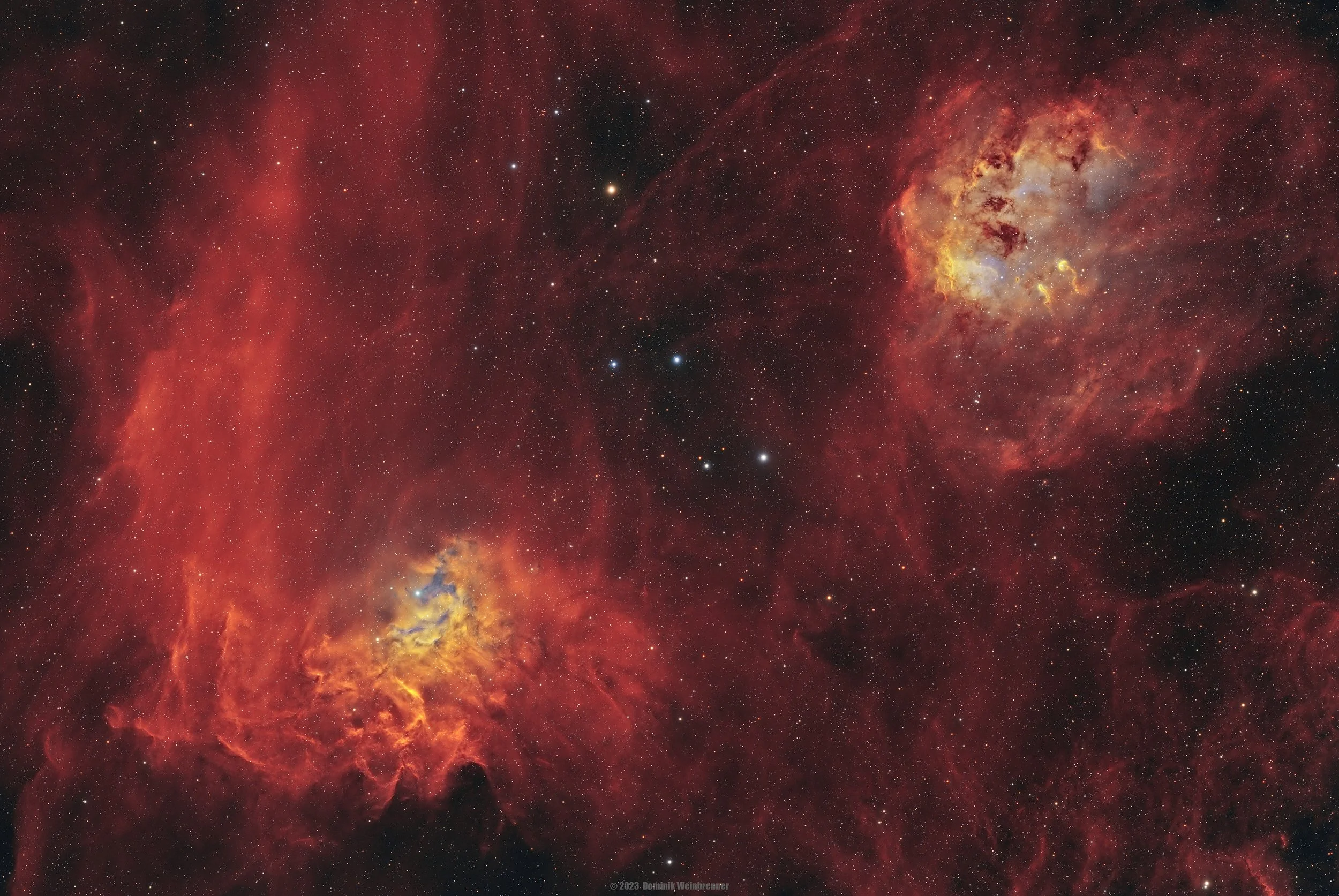
AAPOD2 Image Archives
A Fire In Auriga
In this captivating bi-color image, the dynamic duo of IC 410 and IC 405 unfolds in the cosmic canvas, revealing the ionized gases captured through hydrogen alpha (Ha) and oxygen (OIII) filters. IC 410, also known as the Tadpoles Nebula, unveils its reddish hues, showcasing regions of intense star formation and ionized hydrogen. Meanwhile, IC 405, the Flaming Star Nebula, bathes in the greenish-blue glow of oxygen emissions.
The Tadpoles Nebula within IC 410 features elongated structures resembling tadpoles, sculpted by the powerful stellar winds and radiation emanating from massive stars within the nebula.
Illuminated by the runaway star AE Aurigae, IC 405 is believed to have been ejected from the Orion Trapezium Cluster millions of years ago, contributing to the unique dynamics of this cosmic region.
ic405/ic410/ngc1931- 3 panels mosaic
Image Description and Details :
3 images are combined (32% original size)image 1 : 3 panels mosaic (taken with e-180/ASI094MC)image 2 and 3 : high resolution images (taken with RC10/SX-H694)Date : 8Dec.2021 -16 Dec.2021Place : Gemini Remote Observatory, Lijiang, Yunnan, ChinaTelescope : Tak e-180 ,Mount : Skywatcher EQ8Camera : ZWO ASI094MC(-10ºC ) ,Filters : Baader Ha,LExposure : panel 1 (ic 405 /upper ) L: 180sx 44 , Ha:900sx 6panel 2 (ic 410/ middle) L: 180sx 42 , Ha:900sx4panel 3 (ic 417/ngc1931 lower) L: 180sx 50 , Ha:900sx6(total~ 10.8hr)Guiding : Borg 50 / asi174 ,Image Processing : PI ,PS-CC
Copyright: Alan Van
IC410 - The Tadpoles
Image Description and Details :
The Tadpole nebula or IC 410 is an emission nebula in the constellation Auriga. It lies approximately 12,000 light years from earth.
I don't believe its name needs any explanation, it's one of the few I can see immediately, and I've always struggled with most. This nebula reminds me of a line in one of my favorite songs. "We're just 2 lost souls swimming in a fish bowl". Of course Pink Floyd isn't everyone's thing!
equipment:
Orion RC 8" with CCD47
ZWO ASI 1600MM (-20, gain 139)
Altair 70mm guide scope and ZWO ASI 224 MC
Skywatcher EQ6-r
Integration:
HA - 67x 600 sec
OIII - 5x 600 sec
SII - 5x 600sec
Copyright: Carl Gough
Tadpoles and Flaming Star Nebulae
Image Description and Details :
The Tadpoles Nebula (IC410) and Flaming Star Nebula in the Constellation of Auriga.I took this HaSHO image last week on a very rare almost clear night. In fact it was the clearest night in northern Vermont since last July!. Rather than completing some earlier projects I thought I’d shoot something entirely new, and go for these subjects as they (almost) fit on the same frame at 620mm focal length..The Tadpoles Nebula is so called due to the two light colored tadpole shaped dust and gas clouds that look like they are swimming upwards to the center of the nebula. These are star forming regions, similar to the famous “Pillars of creation” imaged by Hubble in the Eagle Nebula.To get an idea of scale each tadpole is 10 light years long!, more than twice the distance the earth is from its nearest stellar neighbor, Proxima Centauri.To the left is the Flaming Star nebula ( IC 405) which surrounds the variable star AE Aurigae. AE Aurigae is a “runaway” star ejected from gravitational perturbations in the Orion Nebula more than 2 million years ago.Its interesting to note that although these two nebulae appear close together the flaming star is 1500 Light years distant, whereas the Tadpoles Nebula is 12,000 lightyears away and over 100 light years across.This image is processed in the “Hubble Palette where red is aligned with Sulphur emissions, Green with Hydrogen , and Blue with Oxygen .Tech Data : Celestron RASA 11”, CGX Mount, ZWO ASI 6200MMPro cooled (Mono) camera.Ha 12 x 5min, OIII 18 x 5 mins, SII 9 x 5 mins, darks, flats, bias framesSoftware: Stacked in DSS, Processed in Pixinsight and PS 2021
Copyright: Richard Whitehead
IC410 - Tadpoles nebula
IC 410 and surrounding Nebula. With and without stars. Imaged on multiple nights with a total exposure time of 27.8 hours.
Telescope: Takahashi FSQ-106EDX IV
Camera: QSI 683wsg-8
Mount: Software Bisque Paramount MX+
Astrodon Ha: 37x900" -20C bin 1x1
Astrodon OIII: 37x900" -20C bin 1x1
Astrodon SII: 37x900" -20C bin 1x1
Integration: 27.8 hours
Copyright: Craig Patterson






